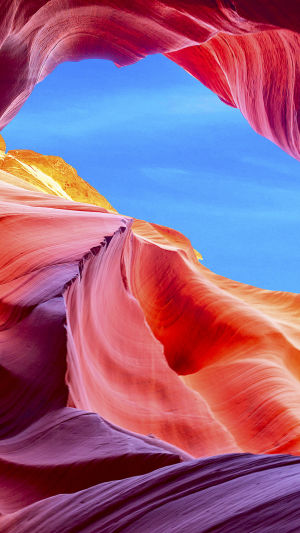Antelope Canyon, located in the northern part of Arizona, USA, is one of the world's most renowned slot canyons and a popular photography destination. It is situated near the city of Page, which is part of the Navajo Aboriginal Reserve.
Antelope Canyon consists of two distinct sections: Upper Antelope Canyon and Lower Antelope Canyon. According to the historical accounts of the Navajo Nation, the area was once a habitat for pronghorn antelope, which frequently roamed the canyon. This is how the canyon acquired its name—Antelope Canyon.
In the past, the older generation of the Navajo regarded this place as a sanctuary for meditation and communing with the Great Spirit.
The exit of Antelope Canyon is only wide enough for a single person to pass through, and the play of light within is ever-changing. Only during a brief period at noon does the sun manage to pierce through several openings, illuminating the depths of the canyon.
Buckskin Gulch, also known as Bell Sheep Valley, is considered the most stunning canyon in North America. It delves deep underground, characterized by its narrowness and grandeur.
The famous red sandstone forms the geological structure of this area. Over millions of years, the soft red sand has primarily eroded due to flash floods, followed by wind erosion, resulting in the enchanting dream-like world we witness today.
Antelope Canyon, a renowned slot canyon worldwide, remains dry throughout the year, resembling a delicate groove where surface sand has been carved away by flowing water. However, as visitors venture deeper into the canyon, they will observe that the rocky surfaces of the walls appear meticulously polished.
Thin laminae flow along the rock walls, resembling waves frozen in time thousands of years ago. Sunlight filters in from the canyon's apex, creating captivating hues and colors.
The allure of Antelope Canyon lies in its distinct geological landscape. Within the canyon, majestic peaks and steep cliffs tower overhead, unfolding before tourists like a magnificent scroll painting. Particularly awe-inspiring is the main peak of Antelope Canyon, standing over 2,000 meters high.
Numerous cascading waterfalls grace the canyon, sending water splashing in every direction and creating a spectacular sight. The canyon's hillsides are adorned with dense forests, imbuing a sense of tranquility and comfort.
Antelope Canyon boasts a unique geological setting. Thousands of years of geological changes, including the movement of the earth's crust, have contributed to the creation of this breathtaking canyon.
Nature has endowed Antelope Canyon with a wealth of diverse geological relics, such as stalactites, stalagmites, and other extraordinary stone formations, inspiring limitless awe and imagination.
Furthermore, Antelope Canyon serves as a remarkable glacial landform relic. On the high mountains surrounding the canyon, remnants of glaciers can be found. These glacial relics have witnessed millions of years of Earth's evolution, offering opportunities for deep exploration and geological research.
In addition to its distinctive geological features, Antelope Canyon also teems with abundant biological resources. Visitors can spot various wildlife and plant species, including Tibetan antelope, blue sheep, snow leopards, and other rare animals that call this land their home. The lush vegetation adds vibrant life and color to this remarkable place.
Antelope Canyon's enchantment lies in its unparalleled geological landscape, where stunning peaks, captivating cliffs, and cascading waterfalls intertwine with the play of light and color.
This natural masterpiece, with its rich biological diversity, invites visitors to immerse themselves in its wonders and contemplate the marvels of nature's craftsmanship.





